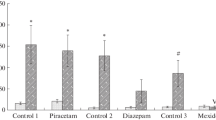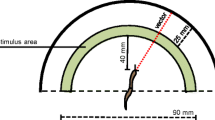Summary
The major purpose of the present experiment was to assess the differential effectiveness of chlordiazepoxide on avoidance response acquisition and extinction. Two groups of rats, one as control and the other treated with chlordiazepoxide were compared on avoidance response acquisition. No significant differences were noted between the two groups, indicating that chlordiazepoxide was not effective in modifying the rate of avoidance response acquisition. The chlordiazepoxide group was then divided into two subgroups, one continued on chlordiazepoxide and the other deprived of chlordiazepoxide for the extinction training. The control group was also divided into two subgroups, one continued as control and the other treated with chlordiazepoxide for the extinction training. These divisions resulted in closely matched subgroups in the number of avoidance response acquisition, making intergroup comparisons of extinction performance possible. This intergroup comparison showed that chlordiazepoxide was effective in modifying the rate and degree of extinction. Less resistance to extinction was shown by the groups specifically treated with chlordiazepoxide during the extinction period, demonstrating that the effectiveness of chlordiazepoxide was confined mainly to the extinction process. These results were evaluated with the view that a conditioned avoidance response is mediated by fear, and an attempt was made to account for the effects of chlordiazepoxide on fear upon which the condition avoidance response is thought to depend.
Similar content being viewed by others
References
Blough, D. S.: Technique for studying the effects of drugs on discrimination in the pigeon. Ann. N.Y. Acad. Sci. 65, 334–344 (1956).
Harris, T. H., and I. M. Cohen: Effects of chlordiazepoxide on psychoneurotic symptoms. Amer. Practit. 11, 999–1002 (1960).
Kamano, D. K., and D. J. Arp: Chlordiazepoxide (librium) consumption under stress conditions in rats. J. Neuropsychiat. (In press.)
Miller, N. E.: Learnable drives and rewards. In S. S. Stevens (Ed.), Handbook of experimental psychology, p. 435–472. New York: John Wiley & Sons 1951.
Mowrer, O. H.: Learning theory and personality dynamics. New York: Ronald Press 1950.
Sidman, M.: Drug-behavior interaction. Ann. N.Y. Acad. Sci. 65, 282–302 (1956).
Tobin, J. M., and N. D. C. Lewis: New psychotherapeutic agent, chlordiazepoxide. J. Amer. med. Ass. 174, 1242–1249 (1960).
Author information
Authors and Affiliations
Additional information
Chlordiazepoxide supplied by Roohe Laboratories, Division of Hoffmann-La Roche, Inc.
Rights and permissions
About this article
Cite this article
Kamano, D.K., Arp, D.J. Effects of chlordiazepoxide (librium) on the acquisition and extinction of avoidance responses. Psychopharmacologia 6, 112–119 (1964). https://doi.org/10.1007/BF00413223
Received:
Issue Date:
DOI: https://doi.org/10.1007/BF00413223




